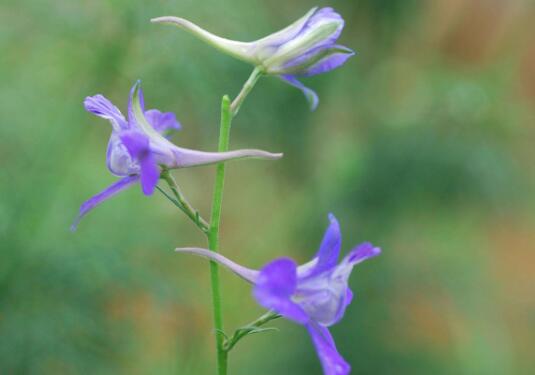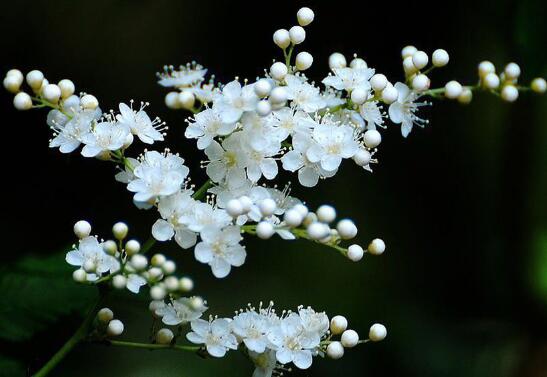Pest control of day lilies, 3 insect pests / 3 diseases / environmental hygiene is the key to prevention.
Hemerocallis is easy to feed, but it may also be threatened by diseases and insect pests, especially when Hemerocallis is not cultured properly, some germs and pests may appear on Hemerocallis, causing the leaves of Hemerocallis to wither and fall off. Today, let's learn about the pest control methods of Hemerocallis.
Pest control of Hemerocallis

Statistics show that the most common pests of day lilies are red spiders, aphids, leaf miners, etc., while the more common diseases are leaf spot, leaf blight, rust and so on. Mainly to look at the symptoms and control methods of these diseases and insect pests.
Common insect pests
1. Red spider
The red spider will feed on the sap of the leaves, which is very destructive to the chlorophyll in the leaves of Hemerocallis, but it is only 0.4 mm long, so it is difficult to detect with the naked eye in the early stage, and when the leaves are yellowing and falling off, the positive and negative sides of the leaves should be carefully examined.
Prevention and cure: avoid too high ambient temperature and too dry air, because red spiders like high temperature and dry environment; spray with 40% triclofenac EC diluted to 1000 times solution.
2. Aphids
Aphids will feed on tender leaves, tender stems and Huawei, which will cause slow growth of Hemerocallis and abnormal discoloration of leaves. Aphids are one of the most common and harmful pests in the pest control of Hemerocallis.
Prevention and treatment: remove the deformed and discolored leaves, and spray the solution diluted to 1000 times with a concentration of 50% marathon emulsion to improve environmental hygiene and prevent eggs from overwintering.
3. Leaf miner
The larvae will whiten and rot the leaves, while the leaves will show white markings, while the adults will leave translucent blisters on the surface of the leaves, which can easily wither the leaves of Hemerocallis.
Control methods: leaf miner adults are usually very good at the upper part of the leaves, to timely remove fallen leaves, reduce the source of overwintering or summer insects; can be sprayed with 1000 times of dimethoate EC.
Common diseases
1. Leaf spot
Day lily leaves appear oval, strip-shaped spot, the spot color is light reddish brown, and then there will be a green circle around, and will gradually expand, and then there will be black spots on the spot.
Control method: remove the diseased leaves and burn them centrally; use 70% mancozeb 500 times, 50% carbendan 500 times, 80% mancozeb 400-600 times alternately to reduce the drug resistance of the bacteria.
2. Leaf blight
There are irregularly shaped spots on the tip or edge of the day lilies. The spots are reddish brown in color, and then become grayish brown. The spots will gradually connect into one piece, and then black dots will be produced on the spots.
Prevention and control methods: pay attention to keep the environment ventilated and transparent, and avoid excessive temperature; at the same time, spray 50% carbendazim wettable powder 500-600 times.
3. Rust
Rust will lead to the condition of falling leaves and poor growth of Hemerocallis. In the prevention and control of diseases and insect pests of Hemerocallis, it is not common but harmful, and serious identification will cause Hemerocallis to die in a short time due to a large amount of internal water evaporation, so even if it is treated.
Prevention and control methods: rust can be spread over a long distance by air flow, the environment should be ventilated, and the temperature should not be too low; spray 1000-1500 times of the three-file wettable powder at the initial stage of the disease, usually once every 10 days, 2-3 times.
Control of common diseases and insect pests of Hemerocallis
Rust disease
Rust and leaf blight are very common diseases of Hemerocallis. Rust is a fungal disease, which is the main disease in the middle and late stage of Hemerocallis. It began to occur in early May, and was the most serious from June to July. It stopped gradually after October, harming leaves and flower moss. At first, a small amount of yellow powdery spots were produced in the leaves, and then gradually extended to the whole leaf, resulting in the death of the whole plant. Fungicides such as strychnine and sodium dirustum could be sprayed to control the disease.
Leaf spot disease
Leaf spot, caused by Fusarium oxysporum, is the main disease of Hemerocallis at seedling stage. It began to occur from the end of March to the beginning of April, and reached the peak from mid-late April to mid-late May. It often occurs in the middle of both sides of the main vein of the leaf, resulting in the interruption of water and nutrient transport after perforation, and the leaf tip turns yellow at first, and finally the whole leaf wilts and dies. Bordeaux liquid or stone sulfur mixture can be sprayed for prevention and control.
Leaf blight
Leaf blight is caused by pathogenic fungi of the genus Alternaria, which is a seedling disease after leaf spot. The disease usually begins in early May and is the most serious in the first and middle of June, which mainly harms leaves and flower moss. The disease occurred from the seedling, the middle edge of the leaf initially produced water-stained dots, then gradually spread upward and downward, forming brown spots, and finally to grayish white, when the whole leaf withered and died. It can be sprayed with 50% carbendazim 600 to 800 times, or Bordeaux solution can be sprayed before and after Qingming to control the main pests of day lilies are red spiders and aphids. Red spiders are small and spider-like red insects, mainly in the back of the leaves to suck juice harm, the victim appears gray-white spots. It can be controlled by 40% dimethoate emulsion, 20% mite fat wettable powder and so on. Aphids mainly occur in May, first harm the leaves, and then suck the juice on the buds, the damaged buds are thin and easy to fall off. It can be controlled by stone sulfur mixture, 40% dimethoate emulsion, 25% marathon EC, tobacco lime water, etc.
In addition, in the breeding experiment of Hemerocallis hemerocallis, it was found that snails did serious harm to Hemerocallis from May to August, so control measures should be taken in time.
Control of diseases and insect pests of Hemerocallis
Xuan has the meaning of Xuan Tang, referring to the place where mother or mother lives, so Hemerocallis is the mother flower of China. There are many nicknames for Hemerocallis, such as "Golden Needle", "cauliflower", "forget worry Grass", "suitable male Grass", "Healing sorrow", "Deer Arrow" and so on. Today, the editor shares with you the pest control of Hemerocallis.
The common diseases of Hemerocallis are leaf spot, leaf blight, rust, anthracnose and stem blight. The main pests are red spiders, aphids, thrips, leaf miners and so on.
Prevention and control of diseases and insect pests: first of all, it is necessary to do a good job in agricultural prevention and control. after picking cauliflower, the aboveground parts die immediately, and they should be cut and transported out of the field in time, so as to reduce the source of bacteria and insects; do a good job in topdressing and winter cultivation of cauliflower to enhance disease resistance; timely renew and rejuvenate old cauliflower; select disease-resistant varieties, and so on. Timely use of medicine to control, diseases can be sprayed with 3000 times of chlorothalonil, and pests can be controlled with 3000 times of Amele.
The above is the disease and pest control of day lilies.
- Prev

What about the growth of swallows? pest control of swallows / 2 insect pests 2 diseases
In the process of breeding swallows, people are most afraid of such problems as diseases and insect pests, which do great harm to plants, which can easily lead to plant death if they are not dealt with in time. What about the swallow worms? What should be done to control diseases and insect pests of swallows?
- Next

What to do with the growing insects of Pearl Plum? pest control of Pearl Plum / 2 insect pests 2 diseases
When people cultivate pearl plum, the last thing they want to encounter is the phenomenon of diseases and insect pests, which does great harm to pearl plum, not only affects the ornamental, but also causes the plant to die if it is not treated for a long time. What about the pearl plum worm? What should be done to control diseases and insect pests of Pearl Plum?
Related
- Fuxing push coffee new agricultural production and marketing class: lack of small-scale processing plants
- Jujube rice field leisure farm deep ploughing Yilan for five years to create a space for organic food and play
- Nongyu Farm-A trial of organic papaya for brave women with advanced technology
- Four points for attention in the prevention and control of diseases and insect pests of edible fungi
- How to add nutrient solution to Edible Fungi
- Is there any good way to control edible fungus mites?
- Open Inoculation Technology of Edible Fungi
- Is there any clever way to use fertilizer for edible fungus in winter?
- What agents are used to kill the pathogens of edible fungi in the mushroom shed?
- Rapid drying of Edible Fungi

